"A cosmic mystery of immense proportions, once seemingly on the verge of solution, has deepened and left astronomers and astrophysicists more baffled than ever. The crux... is that the vast majority of the mass of the universe seems to be missing." -William J. Broad
Three classic observations -- the Hubble expansion of the Universe, the leftover cosmic microwave background radiation, and the observed abundance of the light elements -- lead us inevitably to modeling our Universe as having begun in a hot, dense state from which it expanded and cooled. There is no other explanation that agrees with the known laws of physics that can account for these three phenomena in detail.
But this doesn't tell us what is in the Universe, at least, not on its own. Yes, it tells us there's normal matter -- protons, neutrons, and electrons -- as well as radiation in the form of photons, and we can theoretically extrapolate that there need to be neutrinos as well, based on what we know about physics. But how much? And is there anything else? For that, we need to look at some specifics.
Specifically, when we look at the expansion rate, we look at not just what the expansion rate is now, but also what it was at every point in the Universe's history.
We've made a whole host of observations, including spiral galaxies, elliptical galaxies, variable stars, surface brightness fluctuations, and type Ia supernovae, and they all indicate that the Universe's expansion rate is about 68 km/s/Mpc, that it's decreasing, and that it will asymptote to a minimum of around 55 km/s/Mpc in the far future. (This corresponds to just under 70% of the Universe's energy being in the form of dark energy, or energy inherent to empty spacetime itself.) Because objects that aren't already gravitationally bound continue to expand to greater distances over time (i.e., more "Mpcs"), they'll continue to expand away at ever-increasing rates as the Universe ages.
We also look, in gory detail, at the abundances of the light elements. We have proof that the heavy elements we see today -- Carbon, Nitrogen, Oxygen, and everything heavier -- were all formed in stars, and that only the light elements hydrogen, helium, lithium and beryllium (and their isotopes) were formed in the hot, dense crucible of the early Universe. What the observed abundances tell us is that just under 5% of the total energy content of the Universe is in protons, neutrons and electrons, meaning that about 26% of the Universe is unaccounted for.
And thanks to the incredible observations of Planck (among others), we know that 26% needs to be dark matter.
But what could that dark matter be? From the cosmic microwave background (CMB) alone, we don't learn very much about this matter other than it has to drop in density the same way normal matter does as the Universe expands, it cannot collide very much (if at all) with photons or normal matter, but it does clump and cluster together gravitationally.
Your first guess might be that this could be neutrinos, and for a long time, that was the leading theory.
The Universe is full of neutrinos (and anti-neutrinos) -- some 1090 of them -- left over from the hot, dense state of the early Universe. But we also have measurements of how many species of neutrinos there are (just 3), and measurements of the lower limits (a few hundredths of an electron-volt, from neutrino oscillations) and upper limits (about 2.2 eV-per-neutrino, from tritium decay) of neutrino masses.
If the Hubble expansion rate today were significantly lower, like around 50 km/s/Mpc, neutrinos might be a viable candidate from the CMB alone, but even the meager limits we presently have rule this out.
But we know more than this.
We can look into the early Universe at young quasars, or other ultra-luminous sources. In order to reach our eyes, that light needs to pass through all the clouds of gas that lie in between that light source and ourselves. And based on the absorption features we see in those gas clouds -- how strong and how frequent the absorption lines are -- we can conclude that this dark matter is not hot, which is to say that the speeds it's moving at today are at most around 100 km/s; highly non-relativistic. (Or, in simpler terms, much slower than the speed of light.)
But there are other observations we can make.
We can look at the formation of large-scale structure in the Universe, at how galaxies clump and cluster together. These observations confirm that about 25% of the energy content of the Universe needs to be present in the form of dark matter. We see this whether we look at large-scale clustering from our deepest, largest sky-surveys, individual galaxies that are bound together in clusters, individually rotating galaxies, or galaxy/cluster pairs that are interacting or colliding.
But the large-scale structure observations tell us something even more.
They show us that there's about a 5:1 dark matter-to-normal matter ratio, based on the magnitude of the "wiggles" you can see in the graph above! In fact, all our best observations, combined, point to the same picture of the Universe: mostly dark energy, most of the rest is dark matter, and about 5% is "normal" stuff like protons, neutrons, electrons, photons and neutrinos.
Now, you've likely heard some hype about dark matter being detected, and there's a good reason for this: we know it's there, but we don't know exactly what it is. It could be a very, very low-mass particle (like an axion, in the micro-eV range) that was simply born cold (or slowly moving), or it could be a much higher-mass particle that was born very hot (or moving relativistically) and has slowed down as the Universe has cooled off. These could be anywhere from MeV-range (a few times heavier than an electron) to ~100 GeV-range (around the mass of the Higgs) all the way up to the Yotta-eV-range, or some 1024 eV, for a WIMPZilla!
None of the candidate particles that could be this dark matter are particularly compelling, which makes the puzzle all the more maddening.
Perhaps most frustrating is that, on small scales, the simplest model -- that the dark matter is cold, collisionless, and completely non-interacting except gravitationally -- gives predictions for too much dark matter at the cores of galaxies. In other words, the rotation curves we see should be slightly different if dark matter were truly cold and collisionless.
So maybe dark matter is warm, meaning that it's moving faster than most models predict.
Or maybe it collides either with itself or with normal matter under certain conditions, which would mean that either we should find it annihilating with itself, emitting radiation, or ricocheting off of normal matter, all of which we can detect in principle.
Or maybe it's completely cold and collisionless, but obeys a type of quantum exclusion rule that plays an important role at the cores of dark matter clusters.
Or -- even more controversially -- perhaps there are multiple different components of dark matter, some of which behave in different fashions from others.
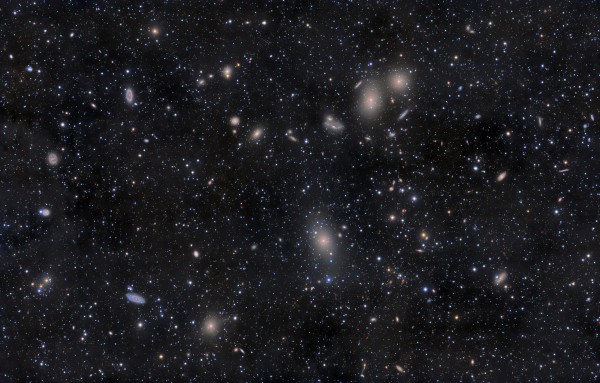 Image credit: Rogelio Bernal Andreo of http://www.deepskycolors.com/.
Image credit: Rogelio Bernal Andreo of http://www.deepskycolors.com/.
Whatever the nature of dark matter, the evidence remains overwhelming in favor of it, but just what it is remains a mystery. Dark matter really matters, but don't be fooled by those telling you we're on the brink of finding it; that's only true if it happens to be one of the few forms we're actively looking for! Most of the candidates we've imagined -- to be quite frank -- we don't even know how to detect in principle! So keep thinking, keep investigating and keep listening, but most of all, keep wondering at just what might be holding the largest structures in our Universe together!
- Log in to post comments

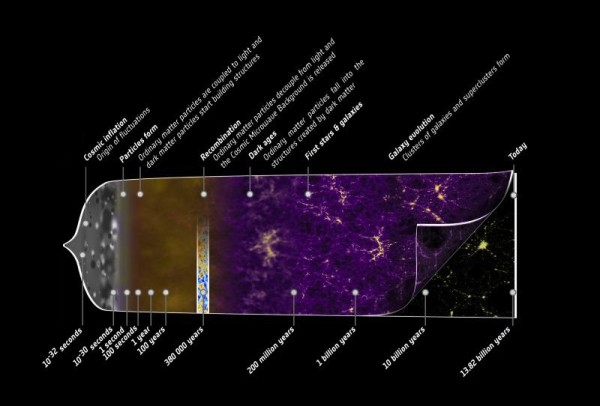
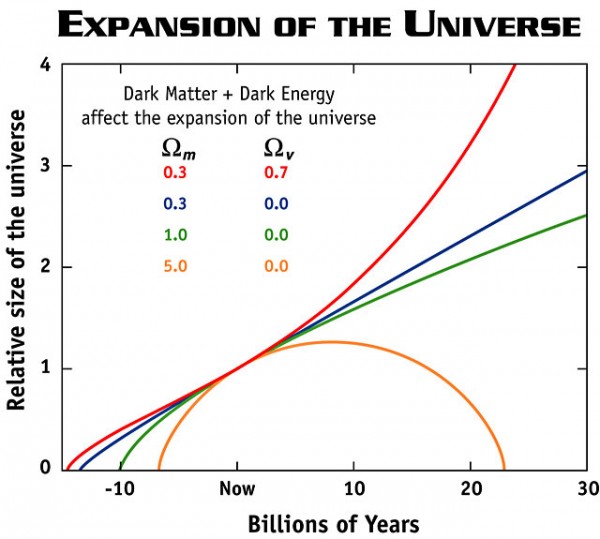
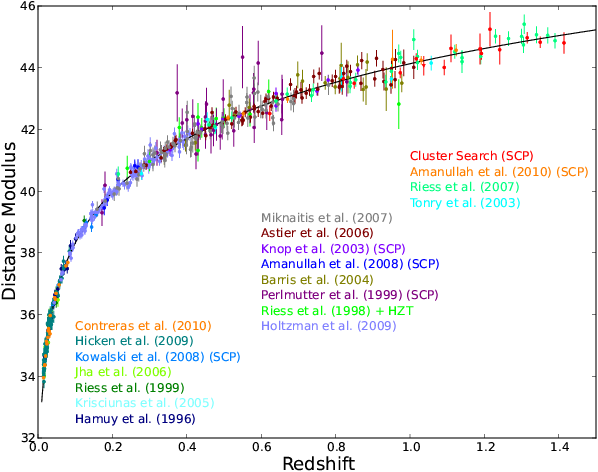

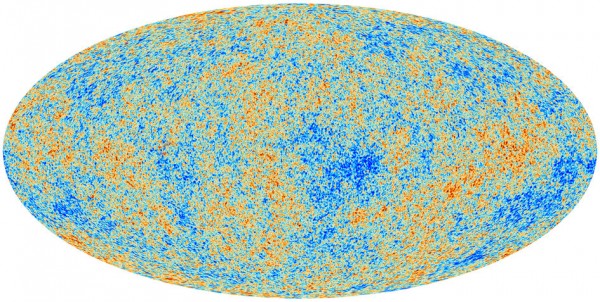
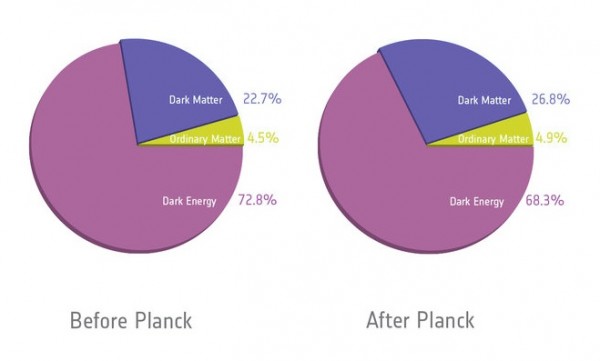
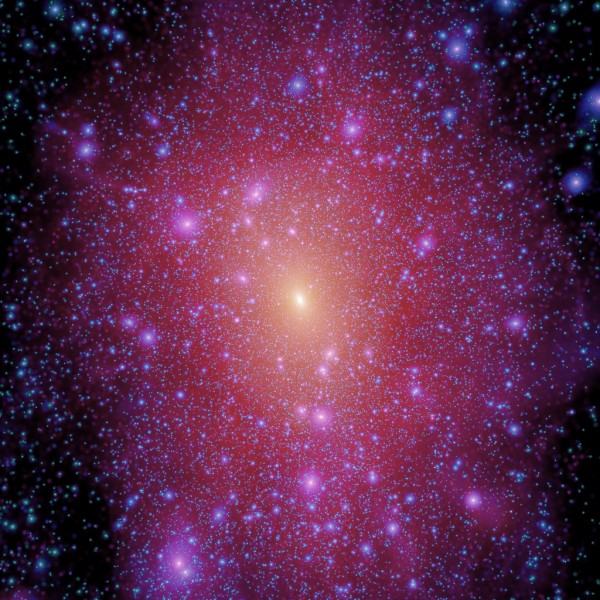
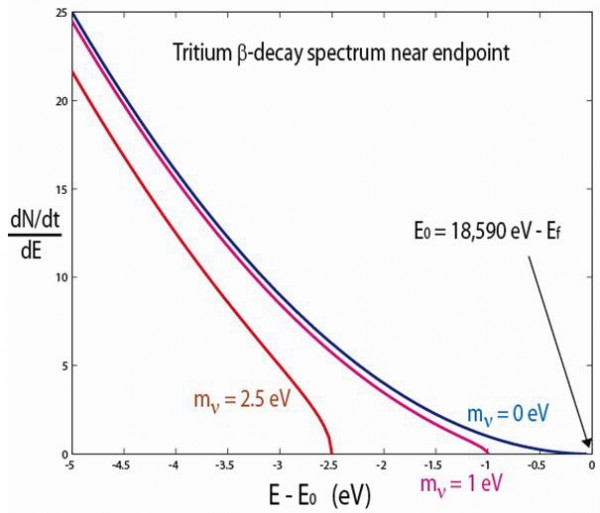
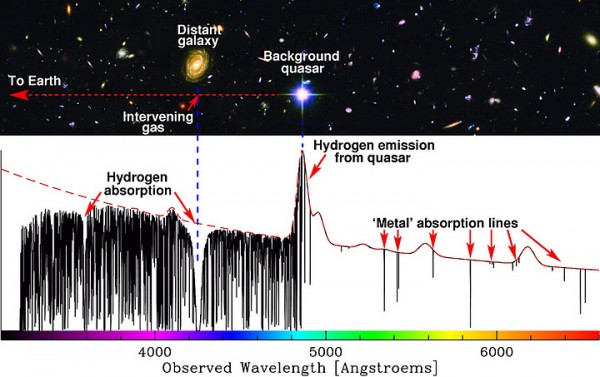
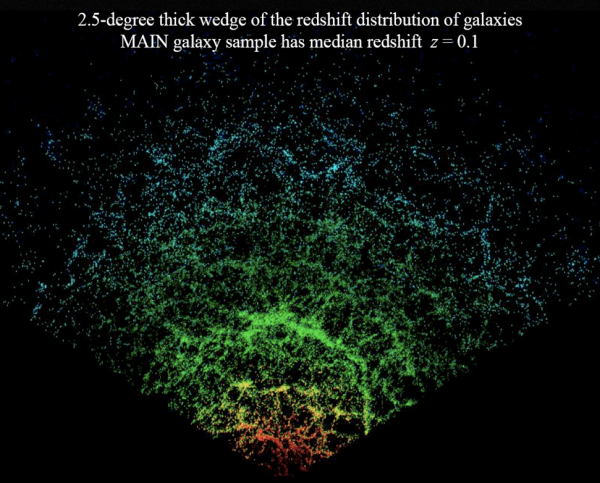
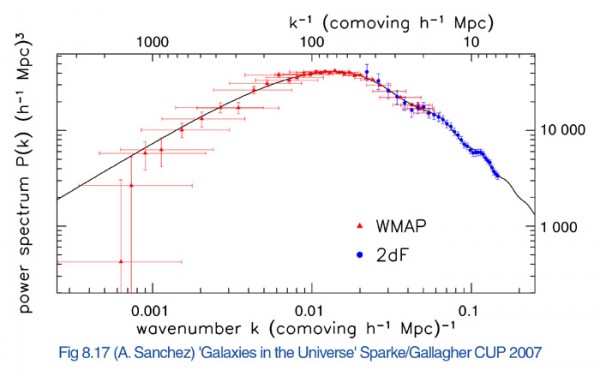
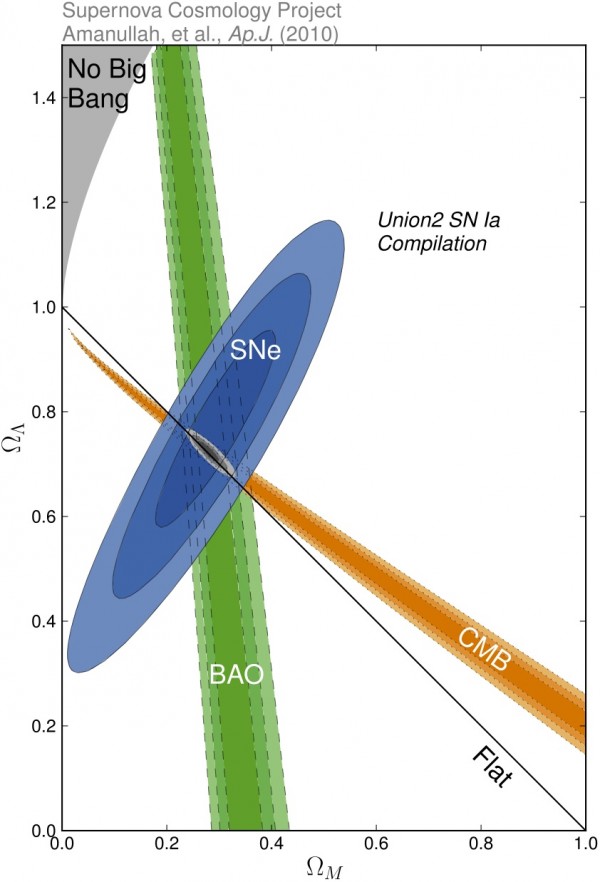
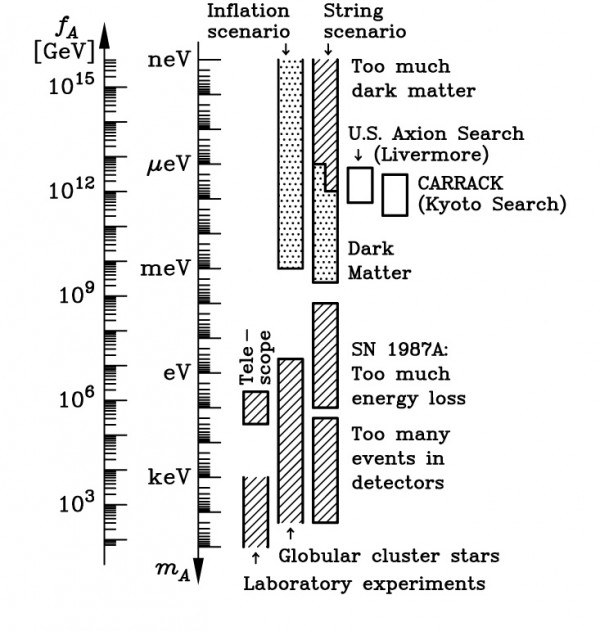
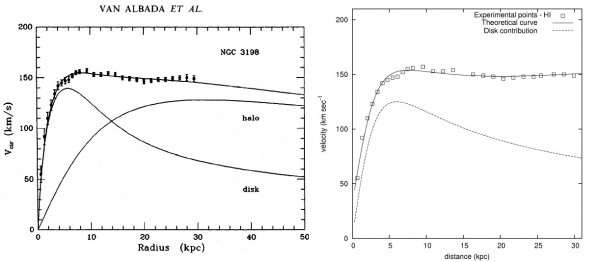
Re the speed of Dark Matter, the Cambridge Institute of Astronomy in 2006 calculated a maximum speed of 9 km/s for DM.
http://news.bbc.co.uk/2/hi/science/nature/4679220.stm
“(Dark Matter) comes in a 'magic volume' which happens to correspond to an amount which is 30 million times the mass of the Sun.
"It looks like you cannot ever pack it smaller than about 300 parsecs - 1,000 light-years; this stuff will not let you. That tells you a speed actually - about 9km/s - at which the dark matter particles are moving because they are moving too fast to be compressed into a smaller scale.
"These are the first properties other than existence that we've been able determine."
From the speculations you made in your post about the unknown nature (hot? cold?) of DM, have the speed estimates of DM made by the Cambridge Institute been rejected?
The speed from the Lyman-Alpha forest -- what I quoted here -- is a different type of constraint than the constraint you quote from dwarf galaxies.
The major difference is the result I quoted definitely applies to all the dark matter in the entire Universe, because it's based off of structure formation and has a huge sample size. The 2nd part of the Gilmore et al. study you quote -- where they re-estimate the mass of the Milky Way -- has been shown to be incorrect, and so I am left, at the very least, skeptical about the robustness of the conclusions they draw for the speed of dark matter, and its applicability to all the Universe's dark matter.
I can't understand if there is a contradiction between what you says here above:
"the Universe’s expansion rate is about 68 km/s/Mpc, that it’s decreasing, and that it will asymptote to a minimum of around 55 km/s/Mpc in the far future."
and what I can read otherwhere about the *acceleration* of the expansion of the universe (see here: http://en.wikipedia.org/wiki/Accelerating_universe for example).
Are you referring to something different?
Thanks in advance for any clarification.
Excellent post. Thank you. I continue to struggle with the whole concept.
There is an explanation for what makes up the dark matter - hydrinos - http://www.blacklightpower.com/wp-content/uploads/papers/21cm-1%20paper…
Can you explain in a little more detail how absorption spectra indicate that the dark matter is not hot? Specifically, how do we learn anything from how gas clouds affect photons about stuff that interacts with neither the gas clouds nor the photons?
@ hronir
It's not a contradiction. The accelerating expansion of the universe refers to the distance between two objects in space over time, which is accelerating. Hubble's Law, which the given 68km/s/Mpc Hubble parameter refers to, is the linear relationship between an object's current distance and its recession velocity.
And because that relationship is linear, and because the objects are receding and therefore getting farther away, their recession velocity will increase with time. They are accelerating.
This will be true even if the Hubble parameter itself decreases, as long as it remains positive.
Click on the "cosmic scale factor" link on that WP page to see the relationship between the scale factor and the Hubble parameter.
Hope that helps.
The mantra of the "dark matter observations" and the "dark energy observations" is this:
MANTRA
95 % of the matter and energy of the universe is missing.
.... 26% is missing "dark matter"
.... 69% is missing "dark energy"
Very nice mantra.
But really! According to which imperfect theory do we arrive at such precise conclusions.
Should we all assume that a better theory of quantum gravity, will NOT absolve these problems, as issues non sequitur.
Remember quantum mechanics did not predict superconductivity. Of course NOW, we explain superconductivity as obvious quantum mechanics.
Here is a related idea seed.
Theory of superconductivity of gravitation and the dark matter enigma http://arxiv.org/pdf/1112.1179v1.pdf
"under very precise astrophysical conditions—Einstein general theory of relativity is formally equivalent to the Ginzburg-Landau theory of superconductivity. This fact lead us to suspect that the superconductivity of gravitation ought to be a real physical process occurring in the outskirts of galaxies. It is found that quantum mechanically gravity can achieve a type-II superconductor state characterized by the GizburgLandau parameter κ = 1.5, and it is suggested that a probability flux of Cooper pairs (quantum gravitational geons charged with vacuum energy) are directly responsible for the flatness exhibited by the rotation curves in spiral galaxies, as well as the exotic behaviour observed in galactic cluster collisions. If this hypothesis proves correct, the whole phenomenon of dark matter may count, after all, as another triumph for Einstein’s theory of gravity" ah nice, very nice idea worth exploring nurturing developing. Not a boring mantra for sure.
So no mantra. I do NOT assert or accept that 95% of the mass and energy of the universe is missing.
Rather I do accept that our current theories of physics are 95% incorrect.
For sure it is a wonder where our standard models of particles, standard models of cosmology, theory of gravity , theory of quantum mechanics are 5% correct.
I mean forget about dark matter, we don't even have a battery that can power a car for 1000 miles. Though of course in theory we shall have one in a self driving car quite soon.
By self admission our current theories collectively misunderstand 95% of the universe.
Yes current physics theory is 95% wrong!!!
And only hubris will declare well
- this 26% error must be missing matter and
- that 69% error must be missing matter.
And well that leaves the current theories quite excellent. Well done chaps!!
Imagine an 18th century gentleman in a 21st century parking lot.
The gentleman remarks, "those carriage are quite elegant; but where do you stable all of the horses?"
Maybe 95% of the horses aren't missing.
I think our understanding of the universe little better than our understanding of 21st century carriages.
And particle accelerators experiments are glorified crash test dummy experiments and testaments to how little we understand carriages or the universe.
OK, so who is pretending to be someone they aren't here...
What do you mean? Seems completely in character to me.
Nah, sounds like Rick DeLano.
In that they grossly misrepresent what we actually don't know about the universe, sure. But OKThen does that on a regular basis, particularly with Dark Matter, and uses the same kind of breathy, poetic but ultimately meaningless turns of phrase seen here.
The clincher though is that there's no mention or indication that this proves the Copernican Principle wrong (all Rick really cares about), but rather refers to a real but as yet underdeveloped and speculative theory. In this case Quantum Gravity, which is also OKThen's bet on the solution for Dark Matter.
This is what makes OKThen so much more tolerable than the crackpot-trolls. At least when exaggerating weaknesses with existing theory, they look to other experts in the field to hopefully provide answers in the future. Rather than immediately shoving in some random-ass thing made up on the spot into the gap and declaring it to be obviously correct.
I have some (probably basic) questions on this:
-If we cannot directly detect dark matter or dark energy, then our basis for assuming how much of the unaccounted energy of the universe is dark matter (specifically) is based on gravitational analysis? In other words, we're looking at what we can see in the universe, how it acts, and determining that there must be some mass there we cannot detect?
-We're also assuming that dark matter is likely on the order of extremely small particles, then? In that event, the differentiation between dark matter and dark energy would be based on, what...function? As in, a boson-related interaction giving it mass? If we're talking about individual subatomic particles free-floating, in my layman's view, I don't see that as all that different from dark energy.
Again, simply questions; I am not a physicist, and I am curious.
Sorry, last question:
-The asymptotic decrease of universal acceleration to a minimum of 55 km/s/Mpc assumes no external pressures or restraints on the universe, and thus eternal expansion, correct? No recurring expansion/compression cycle.
As crazy and hard to read as OK's linked paper is, I do believe it has a piece of the puzzle correct.
The aspect of the dark matter theories centering on as of yet undiscovered particles that rub me wrong is that we NEVER see the amount required to describe the spin of an elliptical galaxy change. Every single elliptical galaxy we see uses the exact same dark matter ratio to correctly model its spin.
If Dark Matter were some sort of particle, it seems that dark matter around galaxies would be as varied as the conventional matter inside the galaxies. Some galaxies would go through collisions that slingshotted all their weakly interacting particles off beyond their realm of influence, and others would wander through clouds of dark matter and pick up some extra dark matter. It never happens. Ever.
MOND has a bunch of problems, but that is one thing it gets right. In that one aspect, it crushes bosonic dark matter.
For my money, I like zero point energy that is subject to Ginzburg-Laudau phase transition. On one side of the transition it acts like Dark Energy, and on the other it acts like Dark Matter. The transition point is effected by the Higgs field or Gravitational field, and so the Dark Matter is always centered around mass.
I've presented the papers here in the past and won't trouble you with them again, but when OK's paper mentioned 'Ginzburg-Laudau', 'Superconductivity', and 'Cooper Pairs', my ears prick up a bit.
"The clincher though is that there’s no mention or indication that this proves the Copernican Principle"
OKThen doesn't generally go completely apeshit and proclaim ALL SCIENTistS HAVE IT WRONG!!! though. He'll fluff up some silly paper but not go all blanket U HAS WRONG!
" Every single elliptical galaxy we see uses the exact same dark matter ratio to correctly model its spin."
Well, we also have "exactly the same planetary body size needed to correctly model the shift of the star it orbits".
And similarly in elementary particles: enough spin to make up the angular momentum modelled.
It isn't *sufficient* to disclaim dark matter. There's no reason that the dark matter ratios have to be the same in every place.
We don't have enough information to say that Dark Matter is wrong or right. We know that IF it exists, it would have to be something like the value given for its mass and concentrations.
"Dark Matter Observations" are observations that cannot be interpreted by any current theory without major contradictions and or major assumptions.
So current theory must be wrong. Why pretend otherwise? Science is not a religion.
for example,
The standard model could be wrong.
General relativity could be wrong.
or...
As well, we are still learning how to interpret certain theories.
For example, does the standard model clarify if neutrinos are their own antiparticle or not. (e.g. a photon is it's own antiparticle)
And until recently, frame dragging of general relativity was a unproven possibility that was ignored and mocked.
Now we have "dark matter observations" with no decisive experiment and no sufficient theory.
So which theory is incorrect or at least needs to be reinterpreted? The standard model of elementary particles? General relativity? Quantum mechanics? Which one?
I don't know have have no real preference. But should do we think the favored hypothesis (i.e. dark matter observations can only be explained by a new particle) is correct.
Where Michelson-Morley correcgt that there must be an aether?
Were physicists correct that neutrinos must be massless particles?
When I hear, "Dark matter is a particle that we've never seem, never observed and it accounts for 26% of the mass/energy of the universe and 80% of the mass of the universe"; I do not hear science, I hear religion, dogma.
Yammering that the universe is made up of 5% observed matter and energy, 26% unobserved matter and, 69% unobserved energy is far from decided. In the sense that it has recently been decided that recent CERN observations are the Higgs boson.
What we have is current theory that says, if our theory is correct then we do not understand 95% of the universe. And I'm not even talking about extra dimensions. And I'm not talking about the fact that we know next to nothing about the place of the strange quark or the tau in the universe. Or that we have not yet measured whether antimatter is gravitationally attractive or repulsed by matter or something else.
Leading scientific hypotheses don't have particularly good track records when it comes to revolutionary scientific ideas. Because as they say, the universe is stranger than we can even imagine.
So yes, I think the dogma that the "dark matter observations" can only be explained by some new kind of matter particle is religion, not science. Religion is meant to reassure us, yes, yes it is so. Science looks at the conflicting evidence and says, their still are dozen ways to possibly interpret these "dark matter observations".
And being comfortable not knowing is part of being scientifically minded.
So yes, current astrophysics suggest that they don't understand 95% of our observable universe. And I agree, there is a 5% chance that current theories of the universe are approximately correct.
We still don't understand baryon assymmetry.
eternal inflation is a promising idea.
String theory seems to have merit.
Extra dimensions seem unavoidable.
And nobody can even construct a snowflake from the known laws of physics but there they are pretty to observe. Yes link me to the mathematical snowflake paper not the hand waving one.
So we have a nice story of the universe with some big gapping holes. And that is just fine because our story of the universe is science not dogma.
"dark matter observations" are a big gaping hole; nothing understood. No theory. Not even a snowflake theory.
"Despite the new advances in modeling snowflake growth, Libbrecht says, the fundamental mystery about snowflakes—how they form in the first place—is still far from solved. To understand how they grow, “we have to marry the mathematics with the physics, and that’s not been done, partly because we don’t know the right physics,” he says... some of the missing physics may be related to a previously overlooked instability in the changing shape of ice crystals. Libbrecht has urged Garcke to incorporate the proposed instability, which transforms thick prismlike snow crystals into thin plates, in the team’s simulations. Garcke says he and his colleagues are now considering doing so, although he believes other effects may be more important." Scientific American Mar 16, 2012
" Libbrecht says, the fundamental mystery about snowflakes—how they form in the first place—is still far from solved."
Oooh, fail hard.
Water, when cold, freezes.
"So current theory must be wrong."
Does not follow.
Why pretend otherwise? Science is not a religion. All you need is a better theory.
So go get one.
@ OKThen
" some of the missing physics may be related to a previously overlooked instability in the changing shape of ice crystals..."
I found this lecture by Wolfram to be highly interesting.
https://www.youtube.com/watch?v=jNDt1DCE25c
Thanks CB and sorry for my late reply, but I'm still confused.
Precisely in the WP page you mentioned,
http://en.wikipedia.org/wiki/Scale_factor_(cosmology)
I read that the accelerating universe means that the second time-derivative of the scale factor a(t) is positive, but since H is a-dot over a, it seems to me that a-dot-dot>0 should means H-dot>0 which in turns means H should *increase* with time.
What's what I'm missing?
"Dark Matter Observations are observations that cannot be interpreted by any current theory without major contradictions and or major assumptions.
So current theory must be wrong. Why pretend otherwise?"
No pretending: What you said is just untrue. It could be that current theory is wrong, but not necessarily. For example, if Dark Matter turns out to be WIMPs, then neither General Relativity nor the Standard Model will be "wrong" at all. It will only turn out that the SM did not describe every particle in existence. Which is okay, because "no other particles are allowed to exist" is not a property of SM.
Oh, but WIMPs are an assumption, you say! Well, yes, technically they are a hypothesis. And when you craft a hypothesis to explain an observation, what you do is *assume* the hypothesis is true, then work out what the implications of that would be, and test that against reality. So far this hypothesis has done better at that than others.
What, you don't think any assumptions went into the quantum gravity paper you cite as the obvious solution? It is to laugh.
"When I hear, “Dark matter is a particle that we’ve never seem, never observed and it accounts for 26% of the mass/energy of the universe and 80% of the mass of the universe”; I do not hear science, I hear religion, dogma."
No, what you HEAR is the current best hypothesis that matches the data far better than alternatives that assume that all of our current theories are wrong. What you hear is solid science, ready and willing to be disproved.
What you INTERPRET is religion, dogma, because that's what you want to believe. All the motivation for, all the science behind, the hypothesis flew right past you, not affecting your view at all. Because your viewpoint is the dogmatic one. Nice.
Good article Ethan. Your comment noted Denier. For myself I just don't understand why dark matter is assumed to be particulate and why I never seem to hear about inhomogeneous dark/vacuum/spatial energy. And when I see this, I’m puzzled: "this corresponds to just under 70% of the Universe’s energy being in the form of dark energy, or energy inherent to empty spacetime itself." Because in Einstein's 1920 Leyden Address he said this: "the fact that 'empty space' in its physical relation is neither homogeneous nor isotropic, compelling us to describe its state by ten functions (the gravitation potentials gμν), has, I think, finally disposed of the view that space is physically empty". He said space not spacetime, and he said it wasn't homogeneous and wasn’t ‘empty’. In 1916 in the FotGToR he said "the energy of a gravitational field shall act gravitatively in the same way as any other kind of energy". A gravitational field gravitates, but it isn't made of WIMPs. And conservation of energy and the raisins-in-the-cake analogy tells me space expands between the galaxies but not within, so every galaxy is surely surrounded by a "halo" of inhomogeneous space. That's what a gravitational field is. Inhomogeneous dark energy if you prefer. With a mass equivalence. And space is dark, and there’s a lot of it about. For me the real mystery of dark matter is why I never get to hear about things like http://arxiv.org/abs/1209.0563 and http://iopscience.iop.org/0256-307X/25/5/014, and only come across it because I know what I’m looking for.
hronir:
A good question. Yes, a-dot(t) should be increasing. But that's only the numerator of the Hubble parameter. The denominator is just a(t), which is also increasing because a-dot(t) is positive, and increasingly faster because a-dot-dot(t) is positive. It's a differential equation. So depending on their actual values, you can have accelerating expansion where the Hubble parameter is decreasing.
The implications, also given on that WP page, are that for a specific galaxy, we should see it moving from us faster and faster over time. And for a specific *distance*, galaxies that passed that distance earlier were moving faster than galaxies that pass that distance later.
OMG this is fabulous thanks so much Ethan! Love dark matter! It's super amazing!
@Wow [17]
"Well, we also have “exactly the same planetary body size needed to correctly model the shift of the star it orbits”."
If all stars of a given size had the exact same shift, you'd have a point. That is not the case. Some stars have close-in hot Jupiters and have a lot of dopler shift. Other stars do not. The dopler shift of stars vary greatly, and by measuring that shift we can then deduce the planetary mass in orbit around the star.
If Dark Matter were a particle, galaxies would act just like scaled up versions of solar systems. Their spin would vary and by measuring the spin we'd be able to deduce the amount of Dark Matter. This isn't the case. Galaxies of a given size ALWAYS have the EXACT SAME SPIN. There is no variation at all.
I do think there is Dark Matter, and I'm a big believer in the Standard Model. I think we've found what there is to find. I do not believe there is a WIMP or similar weakly interacting particle. The particles I believe are responsible for the effects attributed to Dark Matter (and Dark Energy) are virtual, and part of space itself.
hronir,
Maybe this will help. From a mathematical perspective, the derivitive of the Hubble paramater (H-dot) is not equal to the second deriviate of the scale factor (a-dot-dot). Since H = adot/a, we must apply the quotient rule to find the deriviative of H. In general, if f and g are functions of x, d(f/g)/dx =
(g * df/dx - f * dg/dx)/g^2. Therefore,
Hdot = (a-dot-dot*a - (a-dot)^2)/a^2. H-dot > 0 implies H-dot * a^2 > 0 (since a^2>0). In turn that implies that a-dot-dot*a - a-dot^2 > 0, which finally implies that a-dot-dot*a > a-dot^2, which certainly is possible, and shows that a-dot-dot > 0 does not necessarily imply that H-dot > 0.
If my statement required the exact same shift, you'd have a point there. You don't.
Indeed, each star has a different shift. And we attribute that to a DIFFERENT SIZED PLANET in a DIFFERENT ORBIT.
Hence my point stands, and yours doesn't.
You're going to have to prove that assertion.
Because the model as I understand it has the dark matter interacting weakly with itself, therefore it doesn't partition energy and therefore it won't lose it to radiation or matter ejecting, and hence won't collapse anywhere as quickly as the visible matter.
Hence completely different from your assertion.
Hell, I don't think DM is much of a theory, but your picking holes in it is wholly unsupported.
Get a better theory. Just because you can't do so doesn't mean you can "win" by dragging other theories down.
"If my statement required the exact same shift, you’d have a point there. You don’t. Indeed, each star has a different shift. And we attribute that to a DIFFERENT SIZED PLANET in a DIFFERENT ORBIT."
You missed their point. They are claiming that, unlike stars and planets, every galaxy has the exact same rotation curve based solely on the visible mass, and therefore requires exactly the same proportion of dark matter. This would be like if every star's wobble implied a planet with mass and orbit of constant proportion to the star's mass.
@CB [31]
Thank you CB for understanding the point I was trying to convey.
"They are claiming that, unlike stars and planets, every galaxy has the exact same rotation curve based solely on the visible mass,"
Yes, that's fine. What else should they do? It's an assumption, but a reasonable one given the rather problematical constraints involved in finding out better.
" and therefore requires exactly the same proportion of dark matter"
Pretty certain that's not the case. The link is missing damn near the whole chain.
CB [31] ” and therefore requires exactly the same proportion of dark matter”
Wow [33] "Pretty certain that’s not the case."
@Wow [33]
The paraphrasing in CB's post is correct. Galactic rotation curves are related directly to galactic luminous mass distribution. Always. [1]
Even Ethan who likes to beat the DM drum has admitted there is a real problem with DM as it related to galactic rotation curves.
"MOND is far superior to all models of dark matter in predicting the observed rotation curves of galaxies"
-Ethan
http://scienceblogs.com/startswithabang/2008/01/22/mond-vs-dark-matter/
As stated earlier, MOND has a lot of problems. In no way do I advocate the MOND theory, however the point it brings up about galactic rotation observations not meshing with DM theory are valid.
[1] http://arxiv.org/pdf/astro-ph/0009074.pdf
AMS and LHC are two of the most capable (and maybe most expensive) scientific instruments built to detect particles. Their null results suggest physics is at a Michelson-Morley moment regarding possible explanation of "dark matter observations" as a particle.
"based on what AMS has presented, there is nothing to suggest that they have detected any evidence whatsoever for particle dark matter. The press release.. is misleading. In fact, .. I personally believe it is deceitful" Ethan
So it seems a good time to focus upon the serious however farfetched scientific hypotheses of the "dark matter observations. Maybe especially the farfetched ideas.
We are not going to see better particle detectors than AMS and LHC for a long time.
CB [31] ” and therefore requires exactly the same proportion of dark matter”
Denier, why the hell are you making this shit up???
When in [33] I said:
“They are claiming that, unlike stars and planets, every galaxy has the exact same rotation curve based solely on the visible mass,”
Yes, that’s fine. What else should they do? It’s an assumption, but a reasonable one given the rather problematical constraints involved in finding out better.
Are you REALLY so empty of actual argument that you have to editorialise a completely different conversation to "win" an argument?
Denier, why the hell are you making this shit up???
When in [33] I said:
“They are claiming that, unlike stars and planets, every galaxy has the exact same rotation curve based solely on the visible mass,”
Yes, that’s fine. What else should they do? It’s an assumption, but a reasonable one given the rather problematical constraints involved in finding out better.
And you just took a different part of my response DESPITE MY QUOTING WHAT I WAS RESPONDING TO IN THERE.
Are you REALLY so empty of actual argument that you have to editorialise a completely different conversation to "win" an argument?
Thanks CB and Sean T, actually it was quite a glaring error for me not to perform such a simple derivative!
Without any formula, the point is that H is the *relative* increase of the scale factor (it is the variation of a divided by a itself). So, since a is growing, it could well be that a-dot is increasing but not enough to let the *relative* growth to grow itself.
Thanks again.
To state a question simply, what happens when dark matter falls into a black hole?
We now think the universe is composed of normal matter, dark matter and dark energy. Particularly we think that galaxies have much dark matter in them to balance the rotational rate; there is not enough visible matter.
To provide the balancing role dark matter must feel the gravitational force and, to be invisible, it must not interact with the electromagnetic force in any measurable way. However, feeling the gravitational force means that dark matter should respond to a gravitational field around a black hole.
If there is about five times as much dark matter as normal matter one might reasonably think that the stuff falling into a black hole would be composed of about 83% dark matter and about 17% normal matter.
If black holes are gaining mass six times more rapidly than would be expected from the amount of visible stuff thought to be falling in, what would be the consequences?
Would you see an accelerating rate of accumulation of normal matter?
Is there any guess about why kind of signal would be generated by dark matter being annihilated in a black hole? Or, stated another way, are there any signals that cannot be accounted for by the annihilation of normal matter?
"If there is about five times as much dark matter as normal matter one might reasonably think that the stuff falling into a black hole would be composed of about 83% dark matter and about 17% normal matter."
Probably not. There's much more dark matter than normal, but it's distributed in a huge cloud much larger than the visible galaxy. The density is supposed to be higher in the galactic center, but it's not very high in any case.
Also, for the matter to actually fall into the black hole it has to be on an orbit that intersects. Normal matter self-interacts and slows itself down. Dark matter seems to have minimal self-interaction. So it's more likely to just keep orbiting around the black hole (lots of normal matter does this too, like there are a lot of stars orbiting pretty close to the Milky Way's black hole).
"If black holes are gaining mass six times more rapidly than would be expected from the amount of visible stuff thought to be falling in, what would be the consequences?"
IF it was happening, that I dunno.
“If black holes are gaining mass six times more rapidly than would be expected from the amount of visible stuff thought to be falling in, what would be the consequences?”
Not much. Increased accretion from normal matter can be seen because it interacts with itself as CB says (which we call friction) and heats up and emits X-Rays doing so. Dark matter as required would not, so we wouldn't be able to see anything from an accretion disk and therefore the only change is the increase of the mass of the black hole.
That would require VERY accurate measurements of the mass of a black hole which we currently can only do by orbital mechanics of stars around that object (and that takes time), we're not going to be able to see what rate we *expect* without DM falling in to see if it's greater than expected.
But 6x denser DM doesn't mean 6x greater accretion by a LONG LONG chalk.
Normal matter forms an accretion disk. And something coming in to interact with that disk will have a chance of being captured then spiralled in by friction losses taking away its energy.
DM doesn't have that option and therefore it has to hit the pinprick of the object's event horizon.
The chances of anything hitting that hole are a million to one, they say.
What prevents this hypothesis from value of pursuit?
Dark Matter occupies 80% of the universe by mass. It is the greatest unexplored wonder of scientific pursuit. Cosmology shows where force of gravity overlaps the physical realm with a supra-physical realm. Through observations, science uses empirical methodology to build hypotheses and theories yet, for the bulk of existence, scientist must admit they are in the dark.
Since Dark Matter cannot be observed by any of our sensory inputs, the empirical method is unsuitable for developing a deep and trustworthy hypothesis on this obscured existence. Physics is all about discovering laws of the physical universe; it cannot discover all the possibilities within the non-physical. With 80% of everything hidden from pluralistic pursuit, to explore beyond this shroud, this pragmatic horizon, we need another device. Like Pandora’s Box, understanding lays dormant waiting for the right tool to unlock it. The study of Dark Matter is not physics (as yet), it is metaphysics.
I envision a spectrum of new particles and force carrier particles different from the ones currently studied in physics. Imagine how they are an integral structure of all physical matter rather than having a parallel, unassociated existence. For within this dark we may discover answers to life and the meaning of our universe. We may come to know that consciousness is a meaningful part of Dark Matter and that it commingles with our physical bodies in variations of this unseen spectrum. Lets see past the veil of ignorance. It is time to know our complete selves.
To do this, we need empirical reasoning while envisioning deep outside its reach. Grounded by existing theories and examining time held beliefs, we can employ circumstantial and imaginative reasoning to create a holistic vision for verification of all that there is.
Thanks for reading,
Jerry
As for Dark Energy,
Is it possible that Dark Matter has a negative index on electromagnetic radiation to such a degree that we can not know if far away galaxies are coming or going?
"What prevents this hypothesis from value of pursuit?"
Being somewhat less than half assed gibberish.
"Since Dark Matter cannot be observed by any of our sensory inputs"
No more than the far side of the moon cannot be observed by any of our sensory inputs in the 1940's...
~74% of this universe is dark energy (~69%) and ordinary matter (~5%) + dark matter ~26%.
74% of the elemental mass of this universe is hydrogen. 74% of the Sun's mass is hydrogen and 74% of Jupiter's atmosphere is hydrogen.
~74% of Earth's surface is water. ~74% of our freshwater is in ice caps & glaciers. ~74% of human brain, heart, muscles, and chicken eggs are water.
There were 74 generals in the Continental Army. 74 representatives attended the Constitutional Convention (not at the same time).
On leap years, Albert Einstein's birthday 3.14 is the 74th day of the year.
Our language uses Simple(6,74) English(7,74) Gematria(8,74=G7+E5+M13+A1+T20+R18+I9+A1) with 'the key'(74) of A-B-C becomes 1-2-3(74=A1+B2+C3+B2+E5+C3+O15+M13+E5+S19+1+2+3).
Google: GOD=7_4 Code
how antbody can say normal matter consist only 5%